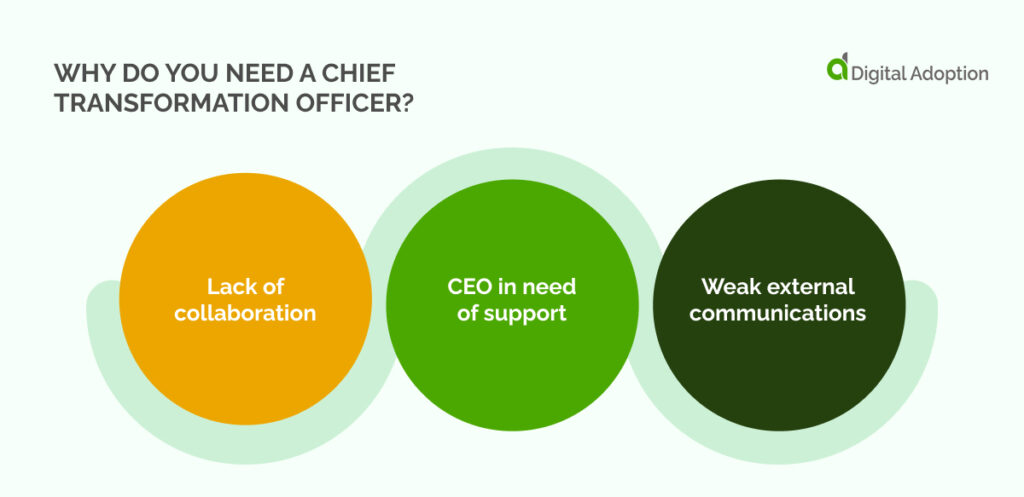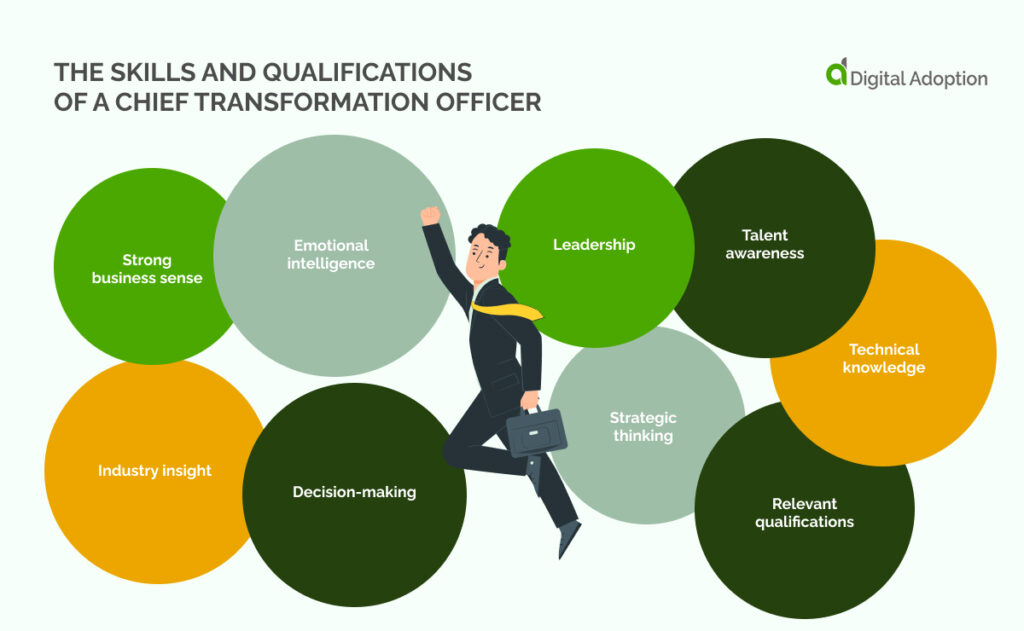A Chief Transformation Officer is crucial for steering adaptability, innovation, and resilience.
Knowing the difference between a chief transformation officer and a chief technology officer is essential to selecting the best person for the role.
A Chief Transformation Officer (CTO) drives organizational change through rigorous research, robust leadership, and excellent communication. These skills are essential for guiding staff through the complexities of organizational transformation and the successful outcome and company-wide embrace of change.
Invest in a chief transformation officer and inform them of their 12 roles to coordinate your transformation and increase revenue.
To help you understand the role of a chief transformation officer and why you need one, we will explore the following topics:
- What is a chief transformation officer?
- What is the difference between a chief transformation and a technology officer?
- Why do you need a chief transformation officer?
- What are the 12 roles of a chief transformation officer?
- What are the skills and qualifications of a chief transformation officer?
- What is a chief transformation officer (CTO)?
- What’s the difference between a chief transformation and a chief technology officer?
- Why do you need a chief transformation officer?
- What are the 12 roles of a chief transformation officer?
- What are the skills and qualifications of a chief transformation officer?
- Choose the right CTO for a successful transformation
What is a chief transformation officer (CTO)?
A Chief Transformation Officer (CTO), sometimes called transformation chief, is a top-level leader who drives innovation, shapes the future, and propels the company forward through strategic, personnel, or technological transformations.
Collaborating with other key executives, such as the CEO and CFO, the CTO plays a pivotal role in enhancing their enterprise’s profitability, ensuring its resilience, and ensuring a competitive edge in the market as part of an employee digital transformation.
Organizations usually hire a CTO when substantial, enduring changes are needed, such as comprehensive internal policy changes, product revamps, or complete corporate repositioning.
What’s the difference between a chief transformation and a chief technology officer?
You may hear chief transformation and technology officers (CTOs) referred to as CTOs.
So, what’s the difference? Let’s compare the two CTO roles to clarify how each differs.
Knowing this difference is essential. It enhances professional relationships, allowing people in different roles to work more effectively together as they understand the differences between their responsibilities and processes.
Chief transformation officer
A Chief Transformation Officer (CTO) leads and implements significant organizational changes, oversees strategic initiatives, drives innovation, and helps you accelerate digital transformation efforts to enhance business growth and sustainability.
Chief technology officer
A Chief Technology Officer leads technological innovation and strategy, implements new technologies, manages technology infrastructure, and develops innovative systems to drive companies toward competitive and innovative tech solutions.
What’s the difference?
The main difference between a chief transformation officer and a chief technology officer is that transformation officers are responsible for change, and technology officers use technology.
Although both roles need strong leaders with extensive technical knowledge and excellent communication skills, chief transformation officers are responsible for implementing large organizational change projects.
In contrast, technology officers focus on innovation through technology.
Despite differing roles, they must work together and understand the value of each skill to help their organization succeed.
Why do you need a chief transformation officer?

Your organization needs a Chief Transformation Officer (CTO) because this role is crucial for guiding organizational changes, driving digital transformation, and enhancing operational efficiency. This is essential in this digital age, where technology means success.
Lack of collaboration
To enhance and promote collaboration, an organization requires a mentor and problem-solving expert to facilitate productive teamwork among employees and encourage cross-functional outcomes that play to the strengths of all disciplines.
This executive will aid in delegation, problem-solving, finance, and operations management, streamlining the organization’s collaboration efforts.
CEO in need of support
The Chief Executive Officer could benefit from the focused attention of a centralized transformation officer to drive global business transformation initiatives in collaboration with the rest of the executive team.
As key collaborators with the Chief Innovation Officer (CIO) and Chief Financial Officer (CFO), CTOs oversee the implementation of innovation and change management strategies within the organization.
Weak external communications
CTOs handle the company’s external communications responsibilities, including informing vendors about policy changes and collaborating with partners to ensure consistent implementation, relieving pressure in the centralized transformation office.
If you notice the above challenges, consider bringing in a transformation chief.
What are the 12 roles of a chief transformation officer?
Being a transformation chief is complex because change is complicated to implement within a large enterprise.
To be successful, chief transformation officers must be confident in fulfilling various roles at different times to implement a transformation successfully. The first of these roles involves effective delegation.
1. Delegator
CTOs act as delegators, guiding positive change by assigning tasks based on individual skills, thus steering the business towards positive transformations.
They use delegation to redirect individual skills or talents to specific tasks, effectively driving organizational change.
For instance, when overhauling bookkeeping methods, a CTO may assign roles to individuals with relevant expertise, ensuring the strategy’s long-term benefits.
2. Customer advocate
The CTO often serves as a customer advocate, reviewing customer data to understand their needs and expectations.
This may involve research or outreach to understand customers’ wants and implement changes that align with their needs.
By focusing on the customer, a business can attract new customers, foster loyalty, and boost revenue, making the CTO’s role crucial in advocating for customers in decision-making processes.
3. Innovator
CTOs often serve as the company’s innovators, frequently assessing contemporary industry practices, tools, and products concerning its position.
They can concentrate on modernizing company policies, products, and tools to align with current standards and promote an environment of innovation in the future.
With creativity and industry insight, CTOs have the potential to transform a business into an industry frontrunner with new technology and robust leadership.
This role frequently emphasizes long-term planning for the organization, which helps guarantee its ability to adapt to rapid market changes and maintain competitiveness.
4. Narrative developer
CTOs craft a compelling storyline for organizations undergoing substantial transformations to unify the company’s executives, staff, and stakeholders toward a shared objective.
This narrative typically encompasses the company’s history, current industry position, and how the forthcoming changes can propel it ahead of competitors.
By employing a well-crafted story, CTOs aim to foster better employee engagement and customer acceptance of impending changes, transforming feel more inspiring and motivating for all involved.
5. Organizational architect
As organizational strategists, CTOs supervise the company’s organizational framework, making decisions about reporting lines, departmental interactions, and power distribution to maintain the business’s original structure during significant changes.
They also identify challenges in the business structure and ensure a sensible distribution of power.
6. Communicator
Strong communication abilities enable CTOs to effectively convey updates and modifications to internal staff, vendors, and customers.
Proficient verbal and written skills empower them to address questions and requests professionally, while active listening aids in understanding others’ perspectives.
For instance, during an overhaul of internal employee policies, the CTO can address queries or relay them to the leadership team for appropriate responses. Simplifying complex transitions and fostering understanding can alleviate employee hesitation during organizational changes.
7. Negotiator
Amidst a comprehensive business transformation, CTOs negotiate with investors, partners, executives, and employees.
As negotiators and mediators, they consider the needs of all parties and facilitate agreements on specific changes or policies. Additionally, they advocate for the company’s interests, striving for agreements that optimize profitability and minimize costs to align with its objectives.
Furthermore, CTOs clarify how the company’s changes can positively impact stakeholders and mediate discussions on salaries and work conditions.
Their ability to broker mutually beneficial agreements contributes to a harmonious work environment.
Related: Mastering the Art of Negotiation: Essential Skills and Strategies
8. Policymaker
CTOs actively refine and restructure company or workplace policies, necessitating a thorough understanding of policy formulation and industry standards.
They collaborate by leveraging negotiation, communication, and delegation skills to develop modern policies that foster innovation and enhance the customer experience.
As policymakers, they negotiate, draft, and enforce new policies to ensure cohesive business progress and thus avoid significant challenges.
9. Analyst
Effective CTOs analyze the business’s requirements, current standing, and future objectives to devise strategies for achieving these goals.
They assess employee sentiment, financial data, and market trends to formulate actionable plans for optimizing business processes and operational improvement throughout all business transformation efforts.
CTOs also extensively research industry trends, company history, and standards to establish realistic business goals and implement necessary changes.
10. Accountability advocate
A Chief Transformation Officer (CTO) champions accountability among enterprise leaders by establishing clear transformation goals, metrics, and timelines.
They implement robust tracking systems, fostering a culture of responsibility.
The CTO collaborates with leaders to align individual and team objectives with the overarching transformation strategy, ensuring everyone is committed to achieving collective success.
11. Researcher
A Chief Transformation Officer (CTO) needs unwavering confidence in navigating technology landscapes, conducting thorough research, and staying abreast of emerging trends.
This proficiency empowers them to make informed decisions, seamlessly integrate cutting-edge solutions, and strategically drive transformative initiatives that align with the organization’s goals.
12. Collaboration promoter
A Chief Transformation Officer fosters collaboration by creating a culture of open communication, emphasizing shared goals, and leveraging technology for seamless connectivity.
They encourage cross-functional teamwork, breaking silos and ensuring diverse perspectives contribute to innovative solutions.
The CTO promotes collaborative platforms and initiatives, cultivating an environment where collective efforts drive successful transformations.
What are the skills and qualifications of a chief transformation officer?

The Chief Transformation Officer role requires diverse skills and qualifications, as described in the typical CTO job description below.
Strong business sense
A Chief Transformation Officer (CTO) possesses in-depth industry knowledge, including the current market landscape, target audience, and competitors, to run a successful transformation program to completion.
They also comprehend their company’s product or service offerings, the specific challenges the company has encountered and conquered previously, and which growth initiatives have succeeded and failed and why.
This business acumen is a compass for their future decision-making when driving organizational change.
Industry insight
CTOs should stay abreast of current and emerging technology trends to ensure procurement of the right technologies.
They should also support staff to understand why new tools are entering the organization and how to use them. Intimate knowledge of the tech buying process is also essential.
Emotional intelligence
Refined communication and interpersonal skills are vital for success. After all, CTOs must coach people through the most challenging experience of their career: Change.
This task requires the CTO to be an expert in human experience and know how to read emotions. The CTO must support staff in embracing change by understanding how it benefits them in their role throughout change management efforts.
Leadership
CTOs often demonstrate robust transformational leadership abilities, which encompass time management, strategic thinking, and analytical skills, which are also shown by all business leaders.
This blend of skills enables them to make critical decisions and coordinate teams to deliver optimal outcomes in the long run throughout challenging digital transformation initiatives.
Decision-making
CTOs must adeptly make data-driven decisions regarding resources, tasks, and deadlines in digital transformation programs.
Analytical skills are essential to do so accurately to help departments and their organization thrive, working closely with the chief data analytics officer to achieve this.
Strategic thinking
CTOs must comprehend a business’s broader technological change landscape, understanding business units’ challenges and the requisite fundamental changes.
The transformation chief must also understand how a digital adoption platform (DAP) can improve employee training as part of the transformation strategy.
Talent awareness
The chief transformation officer oversees new talent recruitment to drive change, requiring a keen eye for individuals capable of effecting this transformation.
It also enables CTOs to leverage individual talents and inspire employees, fostering a culture of innovation and driving successful organizational transformation that defines their role through a compelling future of work strategy to keep employees motivated and satisfied.
Technical knowledge
While not mandatory, a technical background can help a transformation chief understand industry intricacies and the challenges frontline employees face.
This perspective enables them to break old habits and instigate organizational change.
Relevant qualifications
Any change management or digital transformation qualifications are not essential to becoming a chief transformation officer. However, certified courses in these subjects can prove your experience and theoretical knowledge.
Choose the right CTO for a successful transformation
Choosing the proper Chief Transformation Officer (CTO) is crucial for the success of your organizational transformations.
They must be independent, as they are unbiased and use their experience to drive decisions passionate about technology research and transformation theories, which results in concrete, measurable outcomes.
They must also be adept at addressing organizational challenges and supporting all staff to embrace change throughout their journeys.
One example is how the CTO at the time drove Netflix to move from DVD format to streaming to start this disruptive consumer transformation while promoting innovation in all processes to support their staff to work within a pro-change environment.
The right CTO will inspire employees, make tough decisions, and balance short-term improvement with long-term value, driving positive change and ensuring transformation success through changes that stick, cementing long-term sustainability.
Ensure you choose the proper transformation officer today by initiating the CTO selection processes using a checklist of the above criteria adapted to your organization’s needs to get the right person for the role.













